
Back Swinging London Afrikaans তারুণ্যোচ্ছল ষাটের দশক Bengali/Bangla Swinging London Catalan Swinging Sixties German Swinging Sixties Spanish Swinging London Basque دهه شصت مدرن Persian Svengaava Lontoo Finnish Swinging Sixties French לונדון החוגגת HE
| Part of the counterculture of the 1960s | |
 | |
| Date | 1960s |
|---|---|
| Location | United Kingdom |
| Also known as | Swinging London |
| Outcome | Changing social, political and cultural values |
The Swinging Sixties was a youth-driven cultural revolution that took place in the United Kingdom during the mid-to-late 1960s, emphasising modernity and fun-loving hedonism, with Swinging London denoted as its centre.[1] It saw a flourishing in art, music and fashion, and was symbolised by the city's "pop and fashion exports", such as the Beatles, as the multimedia leaders of the British Invasion of musical acts; the mod and psychedelic subcultures; Mary Quant's miniskirt designs; popular fashion models such as Twiggy and Jean Shrimpton; the iconic status of popular shopping areas such as London's King's Road, Kensington and Carnaby Street; the political activism of the anti-nuclear movement; and the sexual liberation movement.[1]
Music was an essential part of the revolution, with "the London sound" being regarded as including the Beatles, the Rolling Stones, the Who, the Kinks and the Small Faces, bands that were additionally the mainstay of pirate radio stations like Radio Caroline, Wonderful Radio London and Swinging Radio England.[2] Swinging London also reached British cinema, which according to the British Film Institute "saw a surge in formal experimentation, freedom of expression, colour, and comedy", with films that explored countercultural and satirical themes.[1] During this period, "creative types of all kinds gravitated to the capital, from artists and writers to magazine publishers, photographers, advertisers, film-makers and product designers".[2]
During the 1960s, London underwent a "metamorphosis from a gloomy, grimy post-war capital into a bright, shining epicentre of style".[2] The phenomenon has been agreed to have been caused by the large number of young people in the city—due to the baby boom of the 1950s—and the postwar economic boom.[2] Following the abolition of the national service for men in 1960, these young people enjoyed greater freedom and fewer responsibilities than their parents' generation,[2] and "[fanned] changes to social and sexual politics".[1]
Shaping the popular consciousness of aspirational Britain in the 1960s, the period was a West End–centred phenomenon regarded as happening among young, middle class people, and was often considered as "simply a diversion" by them. The swinging scene also served as a consumerist counterpart to the more overtly political and radical British underground of the same period. English cultural geographer Simon Rycroft wrote that "whilst it is important to acknowledge the exclusivity and the dissenting voices, it does not lessen the importance of Swinging London as a powerful moment of image making with very real material effect."[3]
- ^ a b c d Wakefield, Thirza (15 July 2014). "10 great films set in the swinging 60s". British Film Institute. Retrieved 5 November 2016.
- ^ a b c d e "Swinging 60s – Capital of Cool". History. AETN UK. Archived from the original on 6 November 2016. Retrieved 5 November 2016.
- ^ Rycroft, Simon (2016). "Mapping Swinging London". Swinging City: A Cultural Geography of London 1950–1974. Routledge. p. 87. ISBN 978-1-317-04734-6.